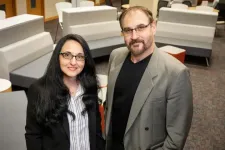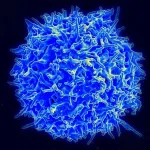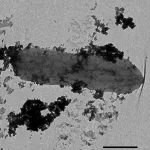(Press-News.org) CHAMPAIGN, Ill. -- Religious people facing life crises rely on emotion-regulation strategies that psychologists also use, a new study finds. They look for positive ways of thinking about hardship, a practice known to psychologists as "cognitive reappraisal." They also tend to have confidence in their ability to cope with difficulty, a trait called "coping self-efficacy." Both have been shown to reduce symptoms of anxiety and depression.
The new findings are reported in the Journal of Religion and Health.
"It appears that religious people are making use of some of the same tools that psychologists have systematically identified as effective in increasing well-being and protecting against distress," said Florin Dolcos, a professor of psychology in the Beckman Institute for Advanced Science and Technology at the University of Illinois Urbana-Champaign, who led the study with psychology professor Sanda Dolcos and graduate student Kelly Hohl. "This suggests that science and religion are on the same page when it comes to coping with hardship," he said.
The research was prompted in part by earlier studies demonstrating that people who are religious tend to use a coping strategy that closely resembles cognitive reappraisal.
"For example, when somebody dies, a religious person may say, 'OK, now they are with God,' while someone who isn't religious may say, 'Well, at least they are not suffering anymore,'" Florin Dolcos said. In both cases, the individual finds comfort in framing the situation in a more positive light.
To determine if religious people rely on - and benefit from - reappraisal as an emotion-regulation strategy, the researchers recruited 203 participants with no clinical diagnoses of depression or anxiety. Fifty-seven of the study subjects also answered questions about their level of religiosity or spirituality.
The researchers asked participants to select from a series of options describing their attitudes and practices.
"We asked them about their coping styles. So, for religious coping, we asked if they try to find comfort in their religious or spiritual beliefs," Hohl said. "We asked them how often they reappraise negative situations to find a more positive way of framing them or whether they suppress their emotions."
The researchers also evaluated participants' confidence in their ability to cope and asked them questions designed to measure their symptoms of depression and anxiety.
Hohl said she looked for correlations between coping strategies, religious or nonreligious attitudes and practices, and levels of distress. She also conducted a mediation analysis to determine which practices specifically influenced outcomes like depression or anxiety.
"If we are just looking at the relationship between religious coping and lower anxiety, we don't know exactly which strategy is facilitating this positive outcome," Sanda Dolcos said. "The mediation analysis helps us determine whether religious people are using reappraisal as an effective way of lessening their distress."
The analysis also shows whether an individual's confidence in their ability to handle crises - another factor that psychological studies have found is associated with less depression and anxiety - "facilitates the protecting role of religious coping against such symptoms of emotional distress," Sanda Dolcos said. "We found that if people are using religious coping, then they also have decreased anxiety or depressive symptoms."
Cognitive reappraisal and coping self-efficacy were contributing to those decreased symptoms of distress, she said.
The study should be of interest to clinical psychologists working with religious clients, Hohl said. "It should also speak to clergy members or church leaders who can promote this kind of reappraisal to help parishioners make sense of the world and increase their resilience against stress."
"I hope this is an example of where religion and science can work together to maintain and increase well-being," Florin Dolcos said.
INFORMATION:
The U. of I. supported this research.
Editor's notes:
To reach Florin Dolcos, email fdolcos@illinois.edu.
To reach Sanda Dolcos, email sdolcos@illinois.edu.
To reach Kelly Hohl, email hohl2@illinois.edu.
The paper "Religiosity and resilience: Cognitive reappraisal and coping self-efficacy mediate the link between religious coping and well-being" is available online [LINK: https://dx.doi.org/10.1007/s10943-020-01160-y] and from the U. of I. News Bureau.
Announcing a new publication for BIO Integration journal. In this opinion article the authors Daiyun Xu, Yonghui Lü, Yongxiao Li, Shengbin Li, Zhe Wang and Junqing Wang from Sun Yat-Sen University, Guangzhou, China discuss ferroptosis resistance in cancer.
Ferroptosis is a lethal consequence of accumulated lipid peroxidation catalyzed by ferrous iron and oxygen. This unique cell death process appears to involve many diseases, such as neurodegeneration, ischemia/ reperfusion injury, kidney disease, and a druggable target in therapy-resistant cancers. Ferroptosis may provide hope for ...
Humans depend on their senses to perceive the world, themselves and each other. Despite senses being the only window to the outside world, people do rarely question how faithfully they represent the external physical reality. During the last 20 years, neuroscience research has revealed that the cerebral cortex constantly generates predictions on what will happen next, and that neurons in charge of sensory processing only encode the difference between our predictions and the actual reality.
A team of neuroscientists of TU Dresden headed by Prof Dr Katharina von Kriegstein presents new findings that show that not only the cerebral cortex, but ...
In a study published in Physical Review Letters, the team led by academician GUO Guangcan from University of Science and Technology of China (USTC) of the Chinese Academy of Sciences (CAS) made progress in high dimensional quantum teleportation. The researchers demonstrated the teleportation of high-dimensional states in a three-dimensional six-photon system.
To transmit unknown quantum states from one location to another, quantum teleportation is one of the key technologies to realize the long-distance transmission.
Compared with two-dimensional ...
In a study published in Advanced Materials, the researchers from Hefei National Laboratory for Physical Sciences at the Microscale, the University of Science and Technology of China of the Chinese Academy of Sciences, using an electron-proton co-doping strategy, invented a new metal-like semiconductor material with excellent plasmonic resonance performance. This material achieves a metal-like ultrahigh free-carrier concentration that leads to strong and tunable plasmonic field.
Plasmonic materials are widely used in the fields including microscopy, sensing, optical computing and photovoltaics. Most common plasmonic materials are gold and silver. Some other materials ...
Scientists at the University of Southampton's Centre for Cancer Immunology have gained new insight into how the immune system can be better used to find and kill cancer cells.
Working with BioInvent International, a team led by Professor Mark Cragg and Dr Jane Willoughby from the Antibody and Vaccine Group, based at the Centre, have shown that antibodies, designed to target the molecule OX40, give a more active immune response when they bind closer to the cell membrane and can be modified to attack cancer in different ways.
OX40 is a 'co-receptor' that helps to stimulate the production of helper and killer T-cells during an immune ...
When Michigan State University's Gemma Reguera first proposed her new research project to the National Science Foundation, one grant reviewer responded that the idea was not "environmentally relevant."
As other reviewers and the program manager didn't share this sentiment, NSF funded the proposal. And, now, Reguera's team has shown that microbes are capable of an incredible feat that could help reclaim a valuable natural resource and soak up toxic pollutants.
"The lesson is that we really need to think outside the box, especially in biology. We just know the tip of the iceberg. Microbes have been on earth for billions of years, and to think that they can't do something precludes us from so many ideas and applications," said Reguera, a professor in ...
Maize has a significantly higher productivity rate compared with many other crops. The particular leaf anatomy and special form of photosynthesis (referred to as 'C4') developed during its evolution allow maize to grow considerably faster than comparable plants. As a result, maize needs more efficient transport strategies to distribute the photoassimilates produced during photosynthesis throughout the plant.
Researchers at HHU have now discovered a phloem loading mechanism that has not been described before - the bundle sheath surrounding the vasculature as the place for the actual transport of compounds such as sugars or amino acids. The development of this mechanism could have been ...
A unifying explanation of the cause of autism and the reason for its rising prevalence has eluded scientists for decades, but a theoretical model published in the journal Medical Hypotheses describes the cause as a combination of socially valued traits, common in autism, and any number of co-occurring disabilities.
T.A. Meridian McDonald, PhD, a research instructor in Neurology at Vanderbilt University Medical Center, has spent 25 years researching autism, from a time she could read literally every research paper on the topic in the 1990s until now, when there is an overload of such studies.
"Up until now there have been a lot of theories about the possible causes ...
In a letter published in the December issue of the American Heart Association's medical journal Circulation a group of researchers at Vanderbilt University Medical Center (VUMC) dispute the most recent findings of the incidence of myocarditis in athletes with a history of COVID-19.
The Vanderbilt study, COVID-19 Myocardial Pathology Evaluation in AthleTEs with Cardiac Magnetic Resonance (COMPETE CMR), found a much lower degree of myocarditis in athletes than what was previously reported in other studies.
"The differences in the findings are extremely important. The whole world paused after seeing the alarmingly high rates of myocardial inflammation and edema initially published," said ...
Across the world, health care workers and high-risk groups are beginning to receive COVID-19 vaccines, offering hope for a return to normalcy amidst the pandemic. However, the vaccines authorized for emergency use in the U.S. require two doses to be effective, which can create problems with logistics and compliance. Now, researchers reporting in ACS Central Science have developed a nanoparticle vaccine that elicits a virus-neutralizing antibody response in mice after only a single dose.
The primary target for COVID-19 vaccines is the spike protein, which is necessary for SARS-CoV-2's entry into ...






